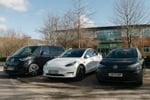The huge choice of EV cars coming on to the market combined with the pressure of emissions targets could drive EV price parity with ICE models.
Nick King, insight director at Auto Trader, speaking at the recent What's New On The Road To 2035 webinar said that while 2023 had been one of lacklustre performance, incentives in the form of discounts being offered by manufacturers over the last six months were significant, indicating a potential shift in pricing strategies.
“We've seen the percentage of discounts offered almost double in the last six months. In January last year the average discount was 4.8%. In December last year, it was 10.6%,” he said.
He cited examples such as the current PCP offer on an MGZS at £299 a month and the VW ID5 which retails at over £51,000 on offer for £440 per month on a three-year leasing deal.
“These are great examples of the kind of value buyers can find especially in the leasing channel as brands look for ways to reach their ZEV commitments, protect market share and move returning new car supply,” said King who added, “We're on the journey to EV price parity due to manufacturer need with more pressure expected in 2024-2025.”
Affordability emerged as a key driver in the used EV market, with falling prices leading to a surge in demand.
“The data shows that as EVs become more affordable there’s a significant increase in response. Where prices fell rapidly at the start of 2022 with oversupply and slowing sales rate, retailers adjusted pricing strategies.
“Some used EVs then reached a point of pricing parity with their ICE counterparts and some became cheaper. As a result, we saw that increase in demand, sales volume increase and speed of sale coming right down.”
The changing dynamics in the used EV market are also likely to impact new car considerations. Unlike the historical distinction between new and used options, EV buyers now have a broader spectrum of choices with another 40 new models due to hit the market in the course of 2024.
Data from Auto Trader suggests that EV consumers are increasingly exploring both new and used options, creating new challenges and opportunities for manufacturers and retailers alike.
“The majority of EV consumers are looking across both new and used. That will increase as supply opens up more choice and alternatives and more used demand may place more pressure on those private new car targets.
“There's going to be increasing pressure on that part of the market and in terms of generating real demand, we're going to see a lot of activity there with efforts from brands and retailers to spur action from primary consumers in particular.”
He said EVs had secured just 16.5% of new car sales in 2023, mirroring 2022’s flat performance and that despite an overall market upswing, EVs struggled to gain significant traction, primarily attributed to a downturn in the retail sector, where sales plummeted by 18.2% year-on-year.
Highlighting the ongoing challenges, King said that while fleet registrations continued to contribute to growth, private registrations had remained disappointing with just under 73,000 units in 2023 - falling far short of the capacity of Wembley Stadium.
On a positive note, he said public charging infrastructure experienced a substantial boost with the number of charging points surpassing the 50,000 mark, marking a near 50% increase from 2022.
According to data from Auto Trader, despite new models entering the market rapidly, the top 10 performers of 2023 largely reflected those of the previous year. Demand for new EVs, measured through client inquiries on its online platform, remained below 20%, however.
He added that one major factor influencing EV interest historically had been fuel prices. With rising geopolitical tensions in the Middle East affecting oil prices, he said there could well be a spike in EV interest.
















Login to comment
Comments
No comments have been made yet.